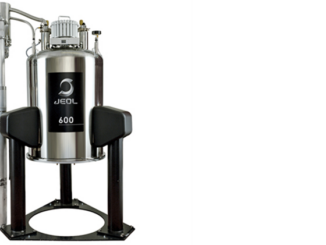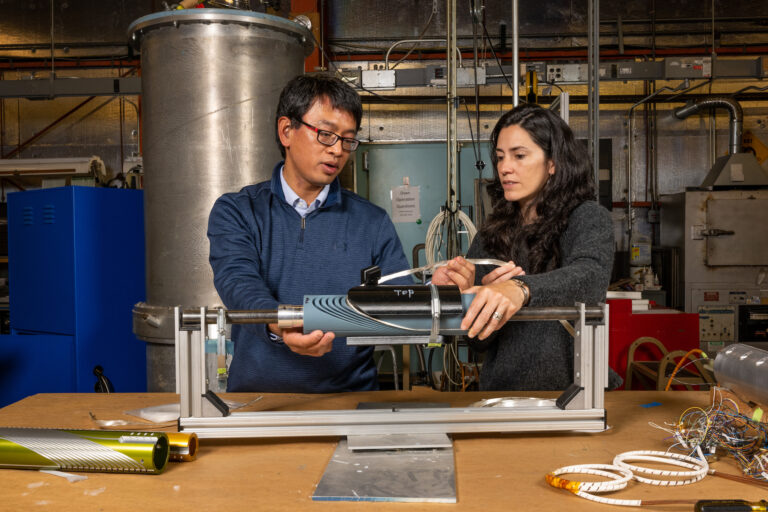
Researchers from the Accelerator Technology & Applied Physics (ATAP) Division at Berkeley Lab, in collaboration with colleagues from the Lab’s Engineering Division and the Applied Superconductivity Center at the National High Magnetic Field Laboratory (NHMFL), have built a new superconducting magnet that shows potential for generating extremely high magnetic fields. It could enable more powerful, energy-efficient particle accelerators that are less expensive to build and operate than current technologies, leading to breakthroughs in high-energy physics and fusion research and enhancing the capabilities of magnetic resonance imaging machines used in medical diagnosis.
Superconducting magnets are essential components of accelerators as they guide the trajectory of the charged particles and determine the accelerator’s energy reach. The highest field magnets installed in an accelerator are those in the Large Hadron Collider (LHC) at CERN. These magnets are made from niobium-titanium (Nb-Ti), which are capable of producing magnetic fields of about 8 T. The High Luminosity Large Hadron Collider (HL-LHC) project aims to upgrade the LHC with magnets made from niobium-tin (Nb3Sn), which can produce fields as high as 11 T.
Nb-Ti and Nb3Sn are low-temperature superconductors (LTS); magnets made from these conductors are operated at liquid helium (the refrigerant used to cool the magnets) temperatures of 1.9 to 4.2 K.
“Although magnets made of Nb3Sn have the potential to generate magnetic fields of up to about 16 T,” says Tengming Shen, a Staff Scientist at ATAP’s Superconducting Magnet Program who led the development of the new magnet, “extending the energy reach of future accelerators will require increasingly powerful magnets, capable of generating very high magnetic fields of 20 T or more.”
While such magnets would enable new areas of research in particle physics, fusion, and medicine, Shen says magnetic fields of this magnitude “are beyond the capabilities of LTS magnets.”
To create more powerful magnets, the researchers turned to novel magnet designs that use superconducting cables made from new materials with high critical temperatures—the temperature at which these cables become superconducting.
These magnets, known as high-temperature superconducting (HTS) magnets, have the potential to generate magnetic fields greater than 100 T and at higher temperatures than LTS magnets. This reduces their reliance on liquid helium, making them much more cost-effective to operate than LTS magnets.
While HTS magnets promise very high magnetic fields, how to turn them into a superconducting accelerator magnet, says Shen, “remains a critical question.”
“For instance, these magnets must be easy to fabricate and capable of maintaining the high critical current density in the strong magnetic fields generated by the superconducting cables. They must also meet several other requirements, including the ability to handle large electromagnetic forces while delivering high magnetic field quality.”
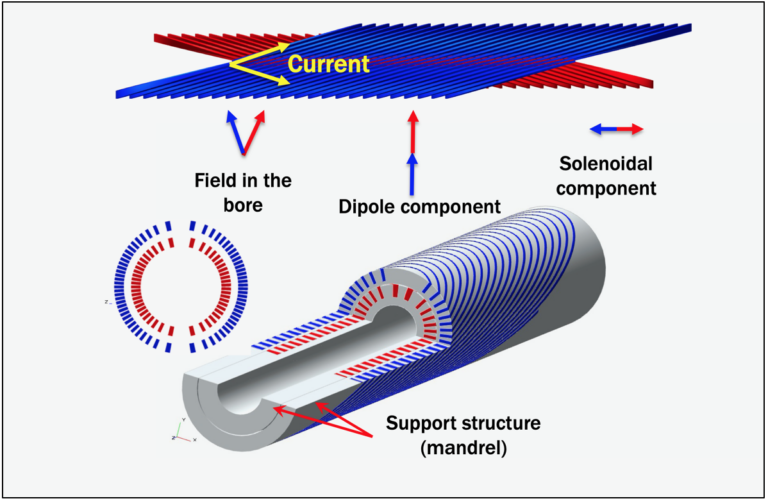
The new magnet is based on a canted-cosine theta design (CCT), which can generate uniform, high-strength magnetic fields. And was constructed using superconducting cables made from a bismuth-strontium-calcium-copper oxide compound—a promising new material for making superconducting cables. Commonly referred to as Bi-2212, it is the only multifilamentary round wire HTS available in long lengths and capable of delivering high critical current density and small magnetization, which are crucial for achieving high field quality.
According to Shen, the magnet “is the world’s first HTS dipole magnet that combines the CCT design with Bi-2212 superconducting cables. It could enable two frontiers; a high-magnetic field frontier and a high-temperature frontier, allowing it to operate at a higher temperature and thereby reducing its reliance on liquid helium, which is expensive and supplies are running low.”
The CCT design also has the advantage of stress management capabilities, which he says are essential because the stress and forces on the magnet increase with the square of the magnetic field. This design, he adds, also allows for magnets “to be fabricated using simpler manufacturing processes than current magnet designs, making them much less expensive to build.”
Shen notes that Berkeley Lab has significant experience in accelerator magnet designs that utilize Nb-Ti, Nb3Sn, and HTS materials like rare-earth barium copper oxide (REBCO)-coated conductors. The Lab, he adds, is part of the HL-LHC upgrade, which is developing a higher-field superconducting magnet made from a niobium-tin alloy.
Furthermore, the new magnet design was also shown to require no quench training during testing. Quenching is a sudden and unpredictable loss in the superconductivity of a magnet and is a long-standing and well-known issue affecting magnet performance. Quench training involves gradually improving magnet performance with repeated quenches at higher and higher currents to reach the desired current.
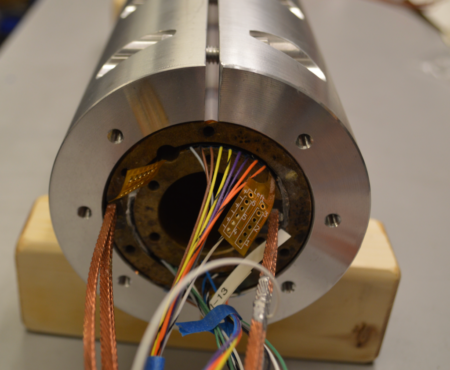
“Most newly constructed LTS magnets undergo quench training before use, often requiring up to 20 quenches. This expends significant amounts of liquid helium through evaporation, which can be very costly and time-consuming,” explains Laura Garcia Fajardo, a Research Scientist at Berkeley Lab’s Engineering Division who was part of the team that developed the new magnet.
However, after just one quench, the magnet’s performance remained the same following subsequent testing. This, says Garcia Fajardo, suggests “minimal training will be required for Bi-2212 magnets, which dramatically reduces costs and shortens development time. We still need to verify this at a larger scale using larger magnets.”
The CCT magnet, she adds, may also have lower magnetic field errors than other magnet designs. “Our magnet showed low magnetic field errors, which provides it with the desired characteristics for use in accelerators, which demand high-quality magnetic fields.”
“This test of an HTS Bi2212 insert coil”, adds Paolo Ferracin, a Senior Scientist and deputy program head of the Superconducting Magnet Program, “is a crucial first step towards the fabrication of superconducting magnets capable of breaking the 16 T limit of LTS and moves towards the 20 T field level—a long-sought goal for the entire superconducting accelerator magnet community.”
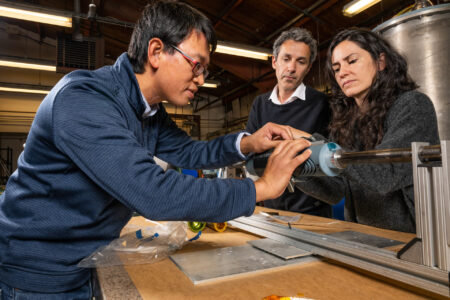
While the development of the magnet is still at an early stage, Shen says their work provides “a blueprint and road map for building new, more powerful magnets that could extend the capabilities of accelerators as well as other technologies that employ superconducting magnets like magnetic resonance imaging.”
The team is conducting further testing on the magnet by inserting it into a large bore Nb3Sn LTS magnet, which they say could pave the way for large, higher field magnets using thicker and higher-current superconducting cables.
“The development of high-temperature superconductor magnet technology,” says ATAP Division Director Cameron Geddes, “will open a new class of magnets for particle accelerators, possibly operating at higher temperatures, leading to more efficient future facilities for high-energy physics. “
The research presented here is from a collaboration between Berkeley Lab and NHMFL and was carried out under the framework of the US Magnet Development Program, which Berkeley Lab leads. The work was funded by the Department of Energy (DOE) – Office of High Energy Physics (OHEP) and the DOE OHEP Small Business Innovation Research program.
To learn more …
- Shen, T., Garcia Fajardo, L., Myers, C., Hafalia, Jr., A., Rudeiros Fernández, J. L., Arbelaez, D., Brouwer, L. Caspi, S., Ferracin, P., Gourlay, S., Marchevsky, M., Pong, I., Prestemon, S., Teyber, R., Turqueti, M., Wang, X., Jiang, J., Bosque, E., Lu, J., Davis, D., Trociewitz, U., Hellstrom, E., and Larbalestier, D. “Design, fabrication, and characterization of a high-field high-temperature superconducting Bi-2212 accelerator dipole magnet,” Rev. Accel. Beams 25, 2022, https://journals.aps.org/prab/abstract/10.1103/PhysRevAccelBeams.25.122401
- Garcia Fajardo, L., Shen, T., Hafalia, A., Arbelaez, D., Brouwer, L., Ferracin, P., Prestemon, S., Rudeiros Fernández, J. L. “Electromechanical Analysis for the Integration of an Nb3Sn and a Bi-2212 CCT Dipole Magnet for a Hybrid Magnet Test,” in IEEE Transactions on Applied Superconductivity 33 (5), pp. 1-5, August 2023, https://doi.org/10.1109/TASC.2023.3264788

